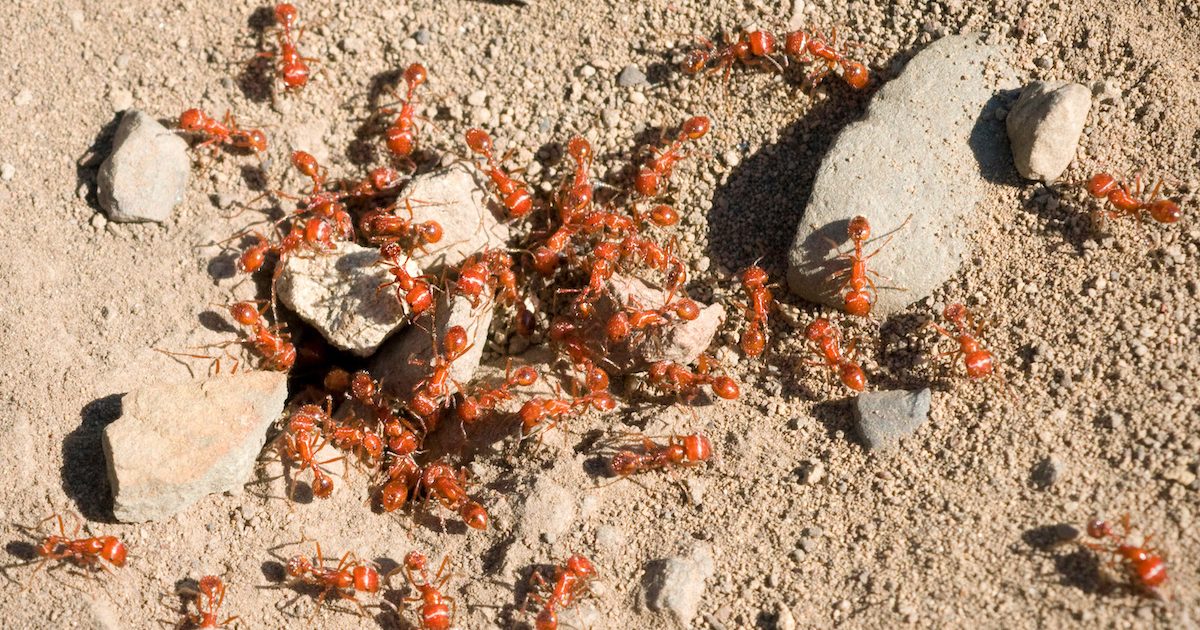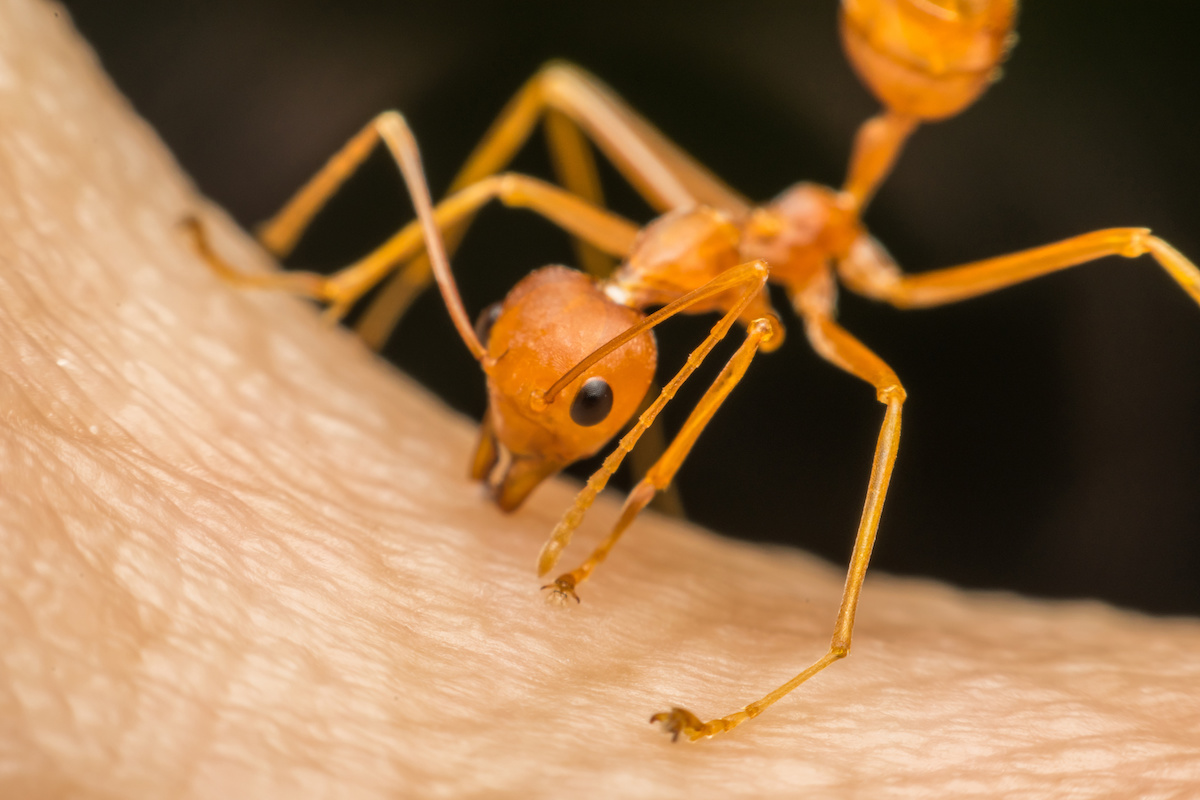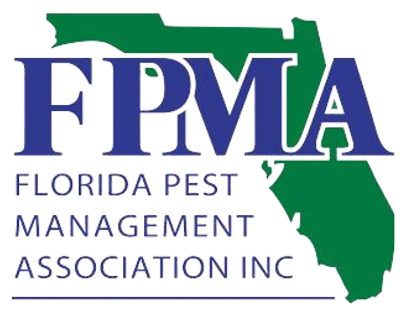
Fire ants aren’t just a nuisance in Florida. They are destructive and can sting their victims many times at once. That’s why the importance of fire ant control in Florida is incredibly important for your health and safety. Fire ant control in Florida is your defense against unwelcome pests, protecting your family, your pets, and your home. It’s more than just peace of mind—it’s essential for a safe, comfortable living environment right here in the Sunshine State.
If you find yourself facing problems with fire ants, this blog can teach you how to keep your yard safe and sting-free.
A Close Look at the Fearsome Fire Ant
Fire ants are incredibly distinctive and hard to miss, sporting a fiery red color and an aggressive demeanor. Despite their small size, they are very active and quick, often found scurrying around in large groups. They construct large mound nests, sometimes as wide as a foot and a half, that are easily visible in your lawn or garden. A useful tip to keep in mind:
Remember, fire ants are defensive. Avoid disturbing their nests or coming too close to them.
Where Can You Find Fire Ants in Florida?
Fire ants are, unfortunately, widely distributed throughout Florida. You’ll find them across the state, from the Panhandle to the Keys, invading yards and public parks alike. They prefer sunny, open areas and thrive in Florida’s warm climate. Using our keyword sparingly, let’s share a few pointers:
- Regularly inspect your yard for fire ant mounds, especially after rainfalls when new mounds are likely to appear.
- Keep an eye on common places they love, like lawns, gardens, schoolyards, and golf courses.
All About Fire Ant Stings
The sting of a fire ant is something you’ll want to avoid. They deliver a painful, burning sting that can cause red, itchy welts or even severe allergic reactions. Pets, too, can fall victim to these small but fierce pests. Here are some sparse but crucial pointers for avoiding fire ant stings:
- Educate children about fire ants and the importance of avoiding their mounds.
- Monitor your pets while they’re outside to prevent them from disturbing fire ant nests.
- If you or your pet get stung, wash the area with soap and water, apply a cold compress, and seek medical advice if necessary.
What are the Signs of a Fire Ant Infestation?
One of the first signs of a fire ant infestation is seeing the ants themselves. They are small, red or brown. You can typically find them in groups. If you’re noticing these pessts frequently in your yard, it’s time to suspect an infestation. A sparse but helpful list of tips includes:
- Check for ants on and around your property, especially after rainfall.
- Watch for ants trailing into your home or other structures.
Recognizing Fire Ant Mounds
When you see a fire ant mound, approach with caution. A surefire sign of a fire ant colony is the presence of their distinctive mounds. They’re dome-shaped, without a visible entrance, and can be quite large. They frequently appear after rain and are commonly found in open, sunny areas. Here are some useful tips:
- Regularly walk through your property to check for new mounds.
- Fire ant mounds are usually visible above the ground, but they can be flat and hard to see in grassy areas.
- If you disturb the mound they will come pouring out of it
Conducting a Thorough Inspection of Your Property for Fire Ants
To identify a fire ant infestation, a detailed inspection of your property is necessary. Look for mounds, watch for ant activity, and inspect any areas where food is stored or discarded. Some simple inspection tips include:
- Early morning is the best time to look for fire ant activity.
- Don’t forget to inspect hard-to-see places like under patio slabs or landscaping features.
Fire Ant Control in Florida: Prevention Tips
Preventing fire ant infestations is a lot easier than getting rid of them. But how do you prevent fire ants from invading your home? Consider the helpful tips.
Maintaining a Clean and Tidy Yard
One of the best defenses against fire ants is keeping a clean and tidy yard. Regularly mow your lawn, trim shrubbery, and remove garden debris. This not only removes potential nests but also makes it easier to spot any new mounds. The best way to do this is by implementing a regular garden routine clean-up. You will also want to keep an eye out for new mounds as you do yardwork.
Removing Potential Fire Ant Food Sources
Fire ants are attracted to a variety of food sources. This includes leftover pet food and certain types of plant material. Be sure to keep pet food indoors or tightly sealed. Meanwhile, regularly clean up fallen fruits or vegetables from your yard.
Blocking Entry Points Into Your Property
Fire ants can find their way into your home through the tiniest of cracks. Therefore, blocking potential entry points is crucial for effective fire ant control. Regularly check and seal cracks and gaps in your home’s foundation. You’ll also want to ensure that doors and windows close tightly.
Natural Fire Ant Control Methods
There are plenty of natural and non-toxic methods to control fire ants. These options are safe for your family, your pets, and the environment. Some ideas include using vinegar spray. Furthermore, citrus peel extracts can kill fire ants–they are toxic to them.
Using Beneficial Nematodes for Fire Ant Control
Looking for an alternative way to get rid of fire ants? Try nematodes. Beneficial nematodes are small, worm-like creatures that can be an effective natural solution for fire ant control. They invade fire ant colonies and can help to significantly reduce their numbers. Before getting started with this method, keep the following in mind:
- Ensure the nematodes are specific to targeting fire ants.
- Apply them according to package instructions for best results.
Applying Diatomaceous Earth as a Natural Barrier
Diatomaceous earth (DE) is a powdery substance made from fossilized aquatic organisms. It’s safe for humans and pets but lethal for fire ants. You can apply it around your property as a natural barrier. Keep in mind these sparse yet valuable tips:
- Sprinkle DE around the perimeter of your home and near fire ant mounds.
- Remember to reapply after rain, as DE loses effectiveness when wet.
First Aid Measures for Fire Ant Stings
A fire ant sting is extremely uncomfortable. However, knowing what to do can help mitigate the pain. First, clean the area with soap and water to prevent infection, then apply a cold compress to reduce swelling. Refrain from scratching the sting site to avoid further irritation or infection.
Helpful tip: Over-the-counter creams or antihistamines can help soothe itching and inflammation.
Recognizing Signs of an Allergic Reaction
While most people experience mild reactions to fire ant stings, some can have severe allergic reactions. Symptoms may include difficulty breathing, swelling of the throat or tongue, dizziness, and nausea.
If any severe symptoms appear, call emergency services immediately.
Seeking Medical Attention When Necessary
If the person stung has a history of allergic reactions or if symptoms persist, it’s important to seek medical attention immediately. Also, if there’s a large number of stings, visit urgent care or the emergency room.
Get Help with Ant Control in Florida with Drive-Bye Exterminators
Are you feeling frazzled over fire ant control in Florida? Drive-Bye Exterminators are here to help. Please reach out to us today if you suspect that you have an infestation.







